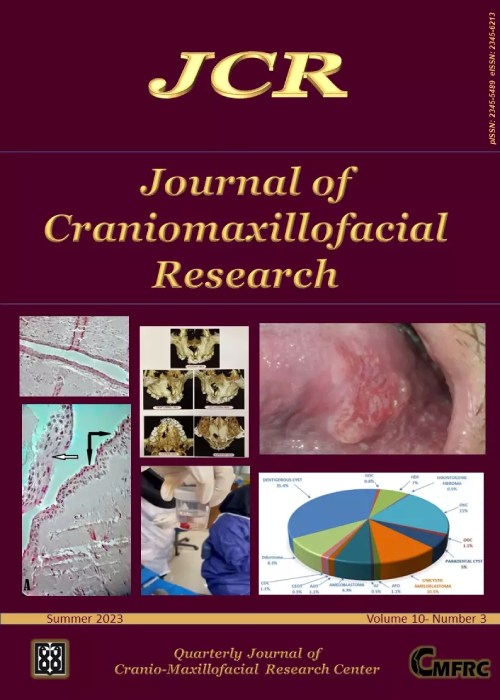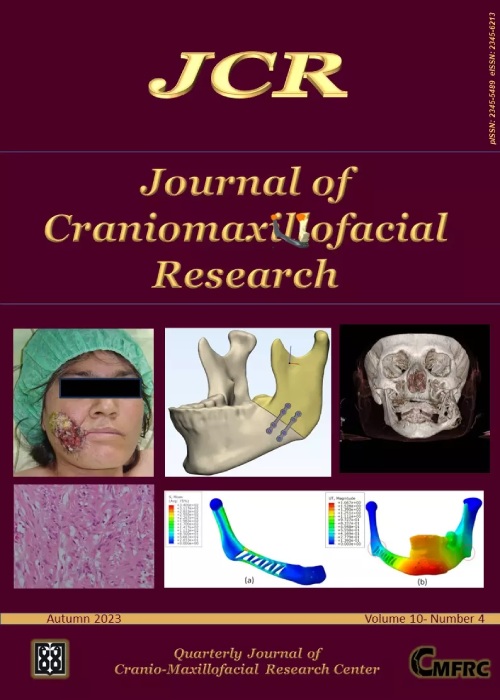فهرست مطالب

Journal of Craniomaxillofacial Research
Volume:10 Issue: 3, Summer 2023
- تاریخ انتشار: 1402/09/29
- تعداد عناوین: 7
-
-
Pages 86-98Introduction
The SARS-CoV-2 virus is a group of viruses that cause disease in birds and mammals and currently has more than 398.572.320 infected and 5.770.578 victims worldwide. Common clinical symptoms are fever, headache, dyspnea, sore throat, dry cough, abdominal pain, diarrhea, and nausea. On the other hand, the results of various studies related to oral and maxillofacial manifestations in patients with COVID-19 have reported contradictory results in different places, which shows the role of different geographical and individual factors in the occurrence of oral manifestations. The aim of the present study was to review the oral and maxillofacial manifestations in patients with or improved COVID-19 infection.
Materials and MethodsThis study is a narrative review. In this study, research published in Pubmed, Google Scholar and Scopus databases has been reviewed by a review method and with a keyword search strategy.
Results4011 articles were found from the mentioned databases, and after deleting unrelated researches (3607 cases) and duplicate researches (358 cases), 46 articles remained for final review. Then, from this number, those research that were presented in the scientific conference and were in the form of abstracts or did not have a correct statistical population were excluded from the study (10 cases).
ConclusionCOVID-19 is a new and rapidly evolving disease, and many of its features, including its associated oral manifestations, are still under investigation. No agreement has yet been reached on the nature and classification of oral lesions in COVID-19 and their causal relationship to disease progression. This limitation is reflected in systematic reviews such as the present article. In addition, there is a significant shortage of high-quality studies on the prevalence of these oral manifestations and this limitation affects the prevalence estimates presented in this study.
Keywords: Oral manifestations, Maxillofacial manifestations, Sars covid, 19 -
Pages 99-106Introduction
Odontogenic lesions related to impacted teeth are common findings in routine dental exams, with the potential to cause tooth pain, displacement, bone expansion, or even bone erosion. Thus, their early detection is important. This study aimed to evaluate the frequency of such lesions based on patient age, gender, and location at the Tehran University of Medical Sciences, School of Dentistry, over five years.
Materials and MethodsThis retrospective study evaluated records from the oral pathology department, covering a five-year period. The association of odontogenic lesions with impacted teeth was assessed. Data on lesion type, patient age and gender, involved jaw, lesion location, and affected teeth were extracted from patient records. Statistical analysis was performed using SPSS 24.
ResultsOut of 815 odontogenic lesions, 44.4% were associated with impacted teeth. The patient distribution was 52.48% male and 47.52% female. Lesions were most prevalent in the third decade of life (24.58%), and third molars (59.39%) were frequently involved. The posterior mandible (68.5%) and mandibular third molar (55%) were common sites. Dentigerous cysts had the highest frequency (35.4%), with odontogenic cysts (developmental) occurring more frequently (70.7%) than odontogenic tumors.
ConclusionThe study underscores a significant association between odontogenic lesions and impacted or unerupted teeth. Periodic follow-ups are crucial for retaining impacted teeth based on these findings.
Keywords: Tooth, Impacted, Odontogenic cysts, Odontogenic tumors, Jaw, Pathology, Oral -
Pages 107-113Introduction
Oral Squamous Cell Carcinoma is the 6th most prevalent cancer worldwide. The global increase in frequency and mortality of oral SCC has been shown. There are few studies about the risk factors for oral SCC in Iran. This study is based on finding a possible relationship between oral SCC and some lifestyle factors in the Iranian population.
Materials and MethodsThis case-control study was conducted at the Iran Cancer Institute in Tehran. The controls were matched to the cases by age and gender and socio-economic status. A number of 204 individuals (102 cases and 102 controls) were interviewed by using a structured questionnaire to obtain data regarding oral hygiene, dietary factors, smoking habits, alcohol consumption and lifestyle risk factors for oral squamous cell carcinoma. Results were analyzed by chisquare and Fisher exact test. P values less than 0.05 were considered significant.
ResultsThe mean age of cases at diagnosis was 60.03 years and 52.9% were male. The analysis showed that poor oral hygiene, low intake of fruits and vegetables (P<0.001), low intake of dairy (P=0.029), alcohol consumption (P=0.015), cigarette smoking (P=0.002) in years and pack per year of smoking (P<0.001) are independent risk factors for oral SCC.
ConclusionThe study provided strong evidence that poor oral hygiene, poor dietary factors, smoking habits and alcohol consumption play an etiological role for oral SCC in the Iranian population.
Keywords: Risk factors, Oral squamous cell carcinoma -
Pages 114-119Introduction
Recurrent aphthous stomatitis (RAS) is a common ulcerative inflammatory condition of the oral mucosa. Considering the contradictory findings of previous research about the association between anxiety and RAS, the present study aimed to determine the prevalence of RAS and its association with anxiety among dentistry students.
Materials and MethodsIn this descriptive-analytical study, a total of 241 dentistry students of G. University were divided into two groups (those with a history of RAS and healthy subjects) after recording their demographic and required information. Also, Cattell’s questionnaire was used to evaluate the level of anxiety. The results were analyzed using SPSS v.21 software, and a p-value of <0.05 was considered statistically significant.
Results2.40% of subjects suffered from RAS. This condition was more prevalent in winter, and its incidence was significantly different between the two groups in terms of the presence of a family history of RAS (p=0.01), food allergy (p=0.05), and regular exercise (p=0.040). Subjects with RAS had a significantly higher anxiety intensity in the areas of lack of ego strength, superego susceptibility, and ergic tension compared to subjects without RAS (p<0.0001).
ConclusionThe results showed that some areas of anxiety, including lack of ego strength, can be predictors of RAS. Therefore, teaching life skills such as anxiety management and its timely diagnosis and treatment can play an essential role in the prevention and treatment of RAS.
Keywords: Recurrent aphthous stomatitis, Anxiety, Dentistry students -
Pages 120-126Introduction
Dentistry is not only an evolving science but also an art with good eye-hand coordination. A variety of magnification devices are used in dentistry to increase the clarity and accuracy of examinations and surgeries. The purpose of this study is to evaluate knowledge, attitude and practice toward using dental magnification among dental residents and dental professors.
Materials and MethodsIn this cross-sectional descriptive study, all professors and residents were studied by census. A questionnaire was administered to the clinical faculty to assess three parameters: knowledge, attitudes and practice of magnification devices among dental residents and masters. The questionnaire consisted of 4 parts: demographic information, knowledge (11 questions), attitude (7 questions), and practice (4 questions). Data were analyzed by SPSS 23 statistical software and analyzed by T-tests and one-way analysis of variance (ANOVA) and Chi- Square.
ResultsA total of 81 dentists completed the research questionnaire, of which 50 (61.7%) were male and 31 (38.3%) were female. Most dentists answered knowledge questions about depth and field of view changes with increasing magnification and the ability to adjust eye convergence under a microscope (74.1%). Also, the results of ANOVA statistical test did not show a significant difference between the scores of dentists’ attitudes according to the field of specialization.
ConclusionAlthough the skill of dentists was acceptable at using magnifying devices, they had little knowledge about the importance of this issue. The most important reasons were mentioned lack of access and high cost of using these devices.
Keywords: Attitude, Dentistry, Knowledge, Magnifying devices, Practice -
Pages 127-131
Dentigerous cyst is one of the most common odontogenic cysts of the jaw that slowly grows around an unerupted tooth crown. Nasopalatine duct cyst is a non-odontogenic common jaw cyst. Co-occurrence of nasopalatine duct cyst and dentigerous cyst in the same location of the same jaw is extremely rare. Odontogenic and non-odontogenic cysts occurring simultaneously in non-syndromic patients is rare. The lesions must be fully extracted by surgery. We report the treatment procedure of a patient suffering from this rare phenomenon.
Keywords: Odontogenic cyst, Nonodontogenic cyst, Impacted tooth -
Pages 132-135
A 39-year-old male was referred to the Oral and Maxillofacial Medicine department of Alborz University of Medical Sciences Dental School with a lesion that he had noticed for 3 weeks. The patient had no signs or symptoms and no cigarette and alcohol consumption. Because the lesion was placed at the lateral posterior portion of the tongue which is a common place for oral malignancies a biopsy was done. The pathology result was Squamous cell carcinoma grade 2. The patient was referred to Imam Khomeini Cancer Institute for further treatment.
Keywords: Oral scc, Oral cancer, Squamous cell carcinoma


